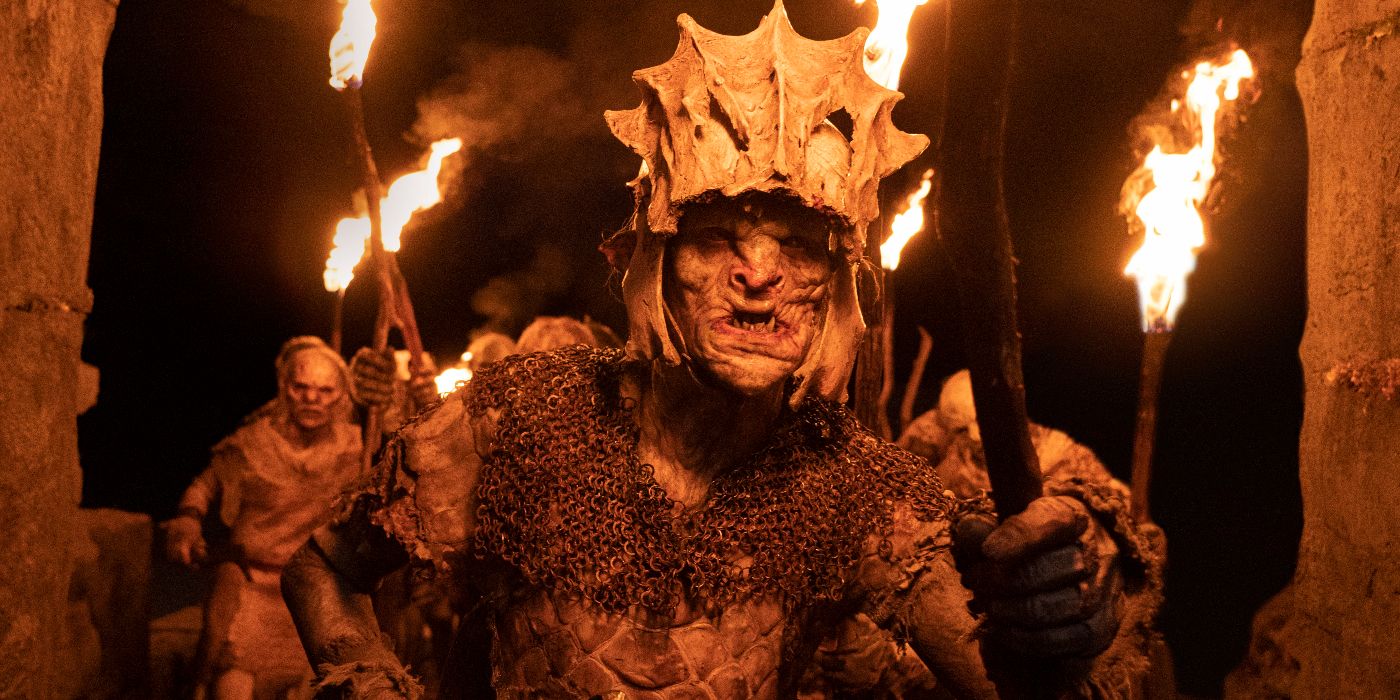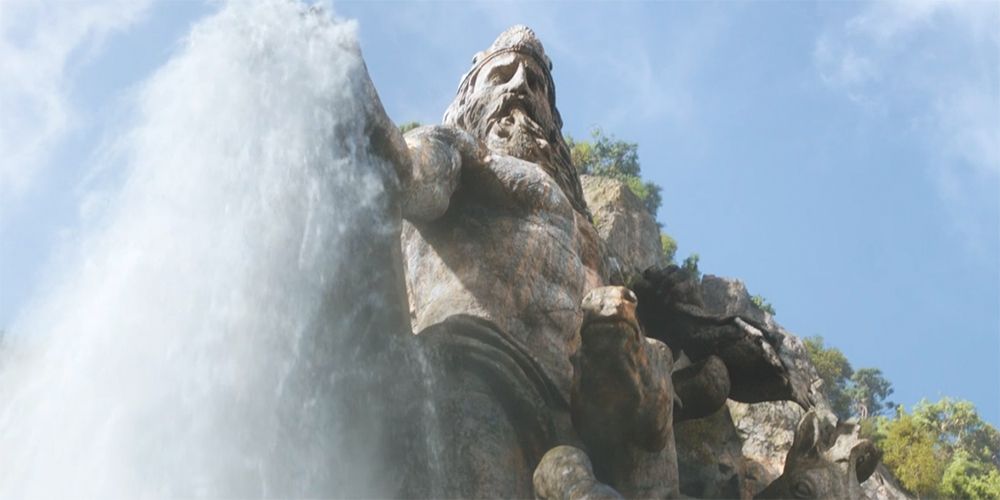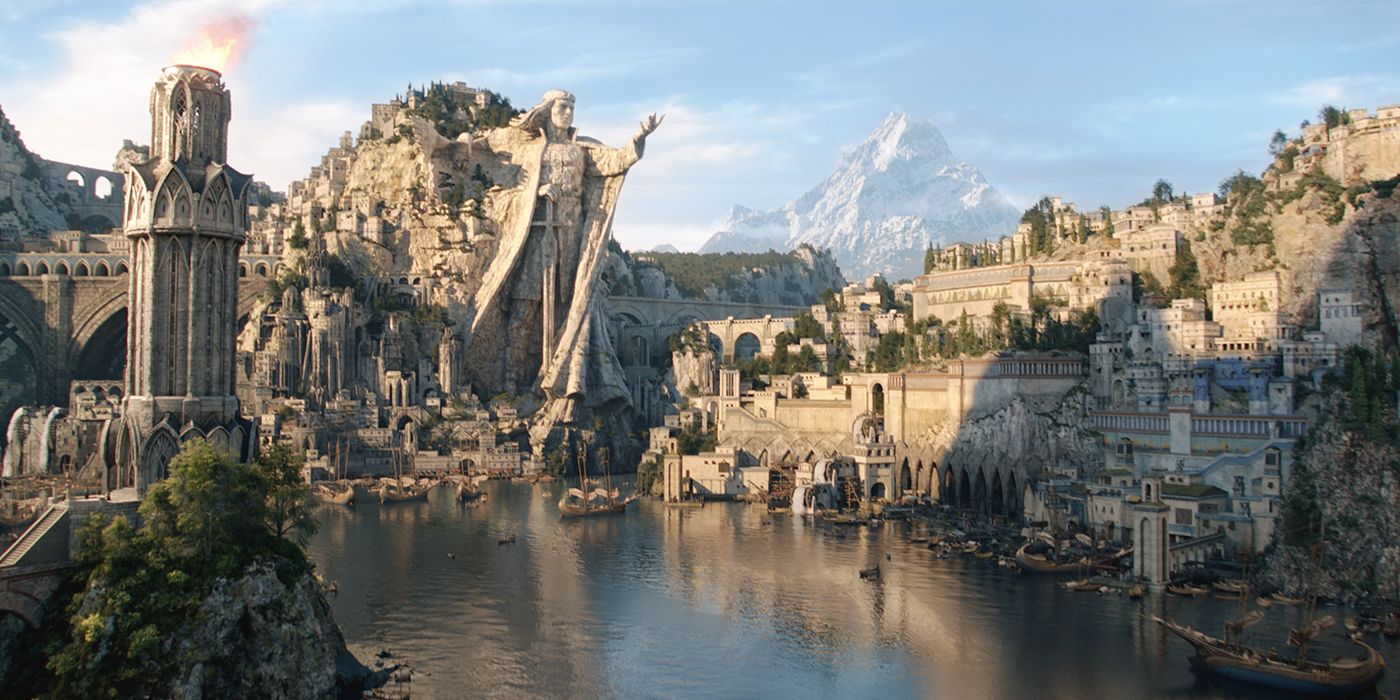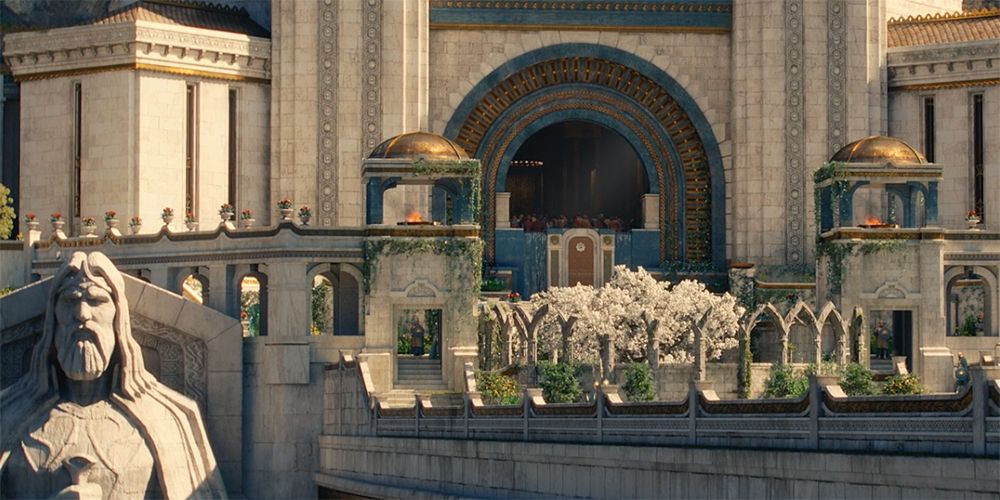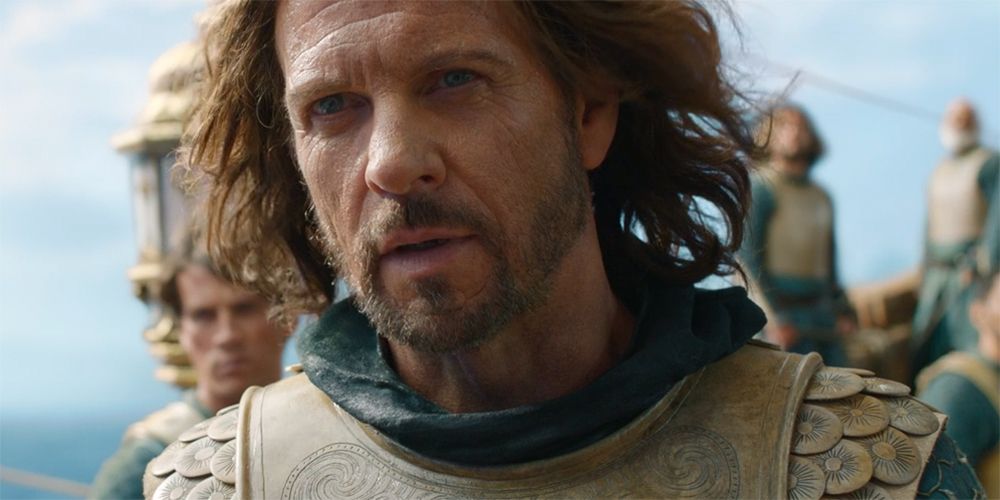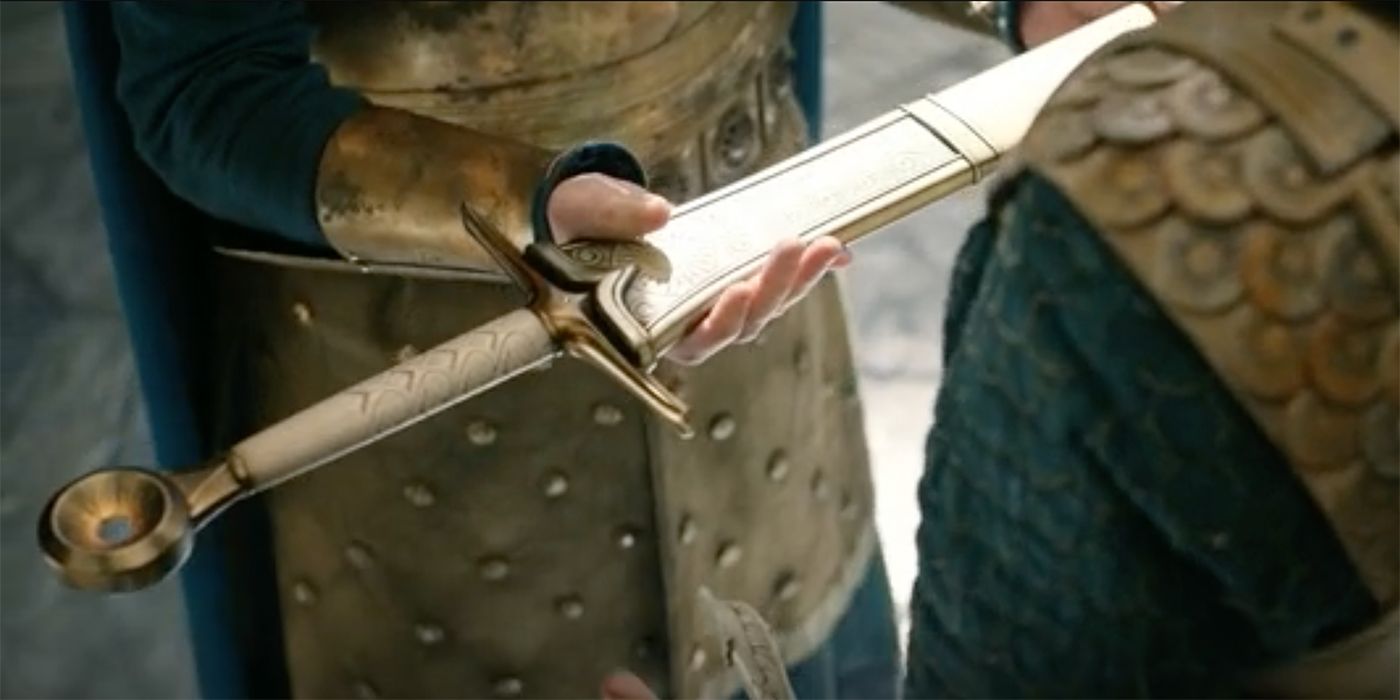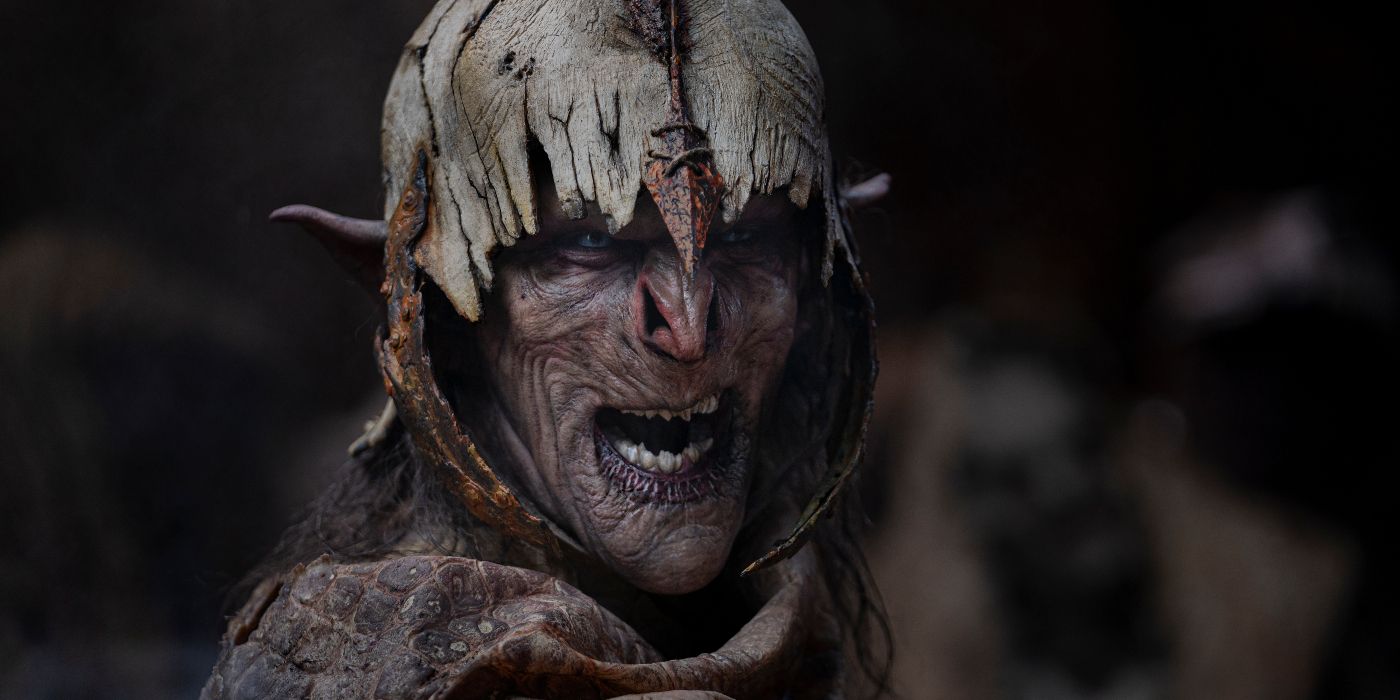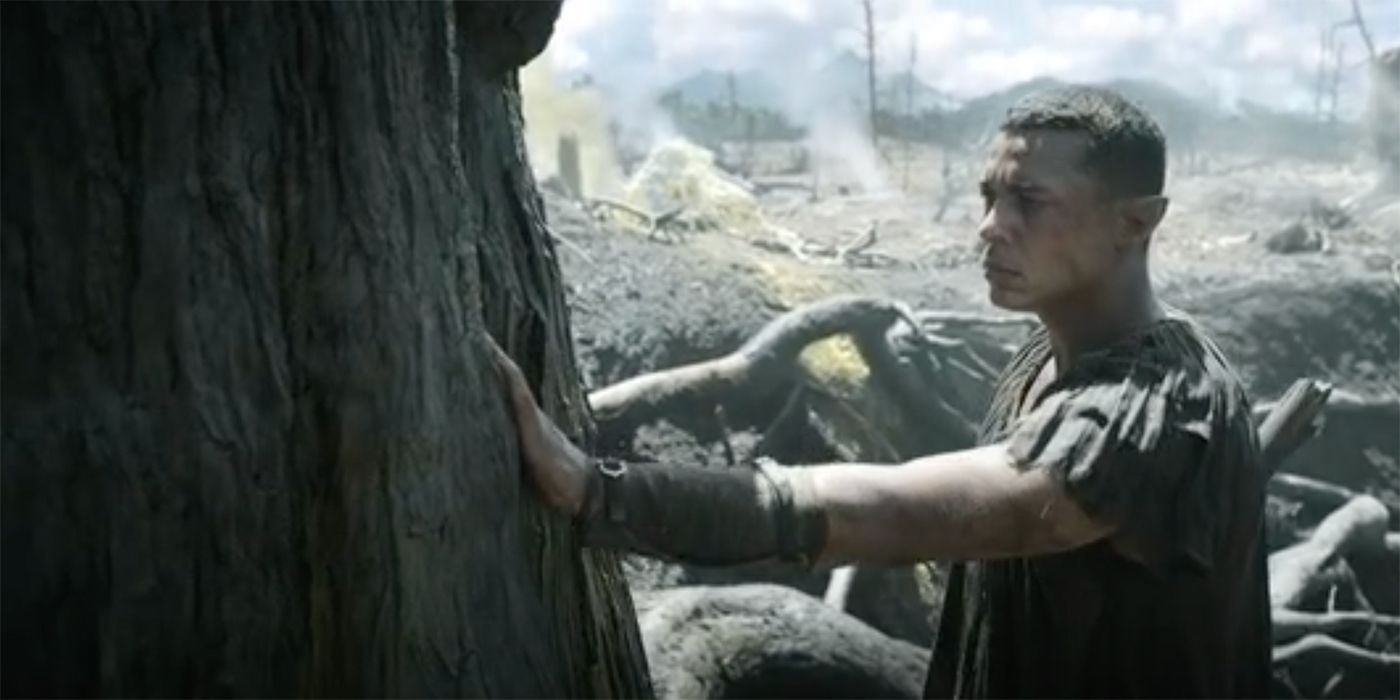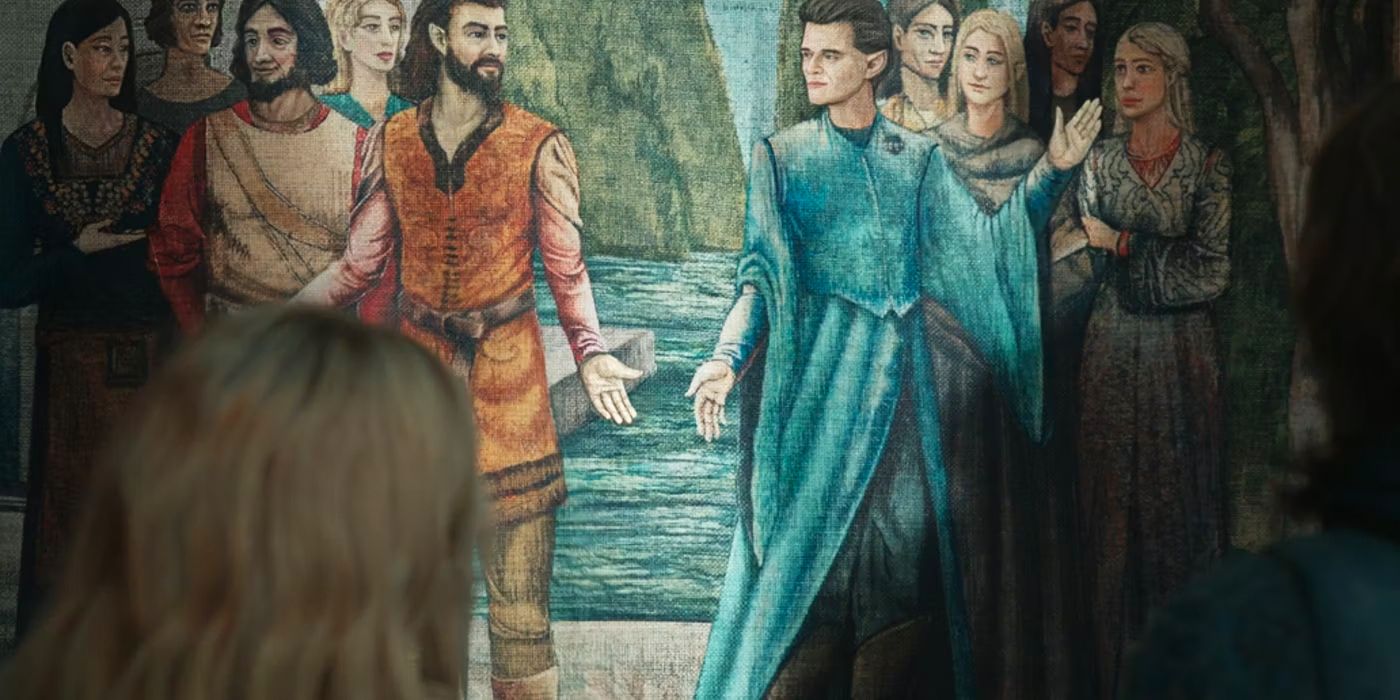The third episode of The Lord of the Rings: The Rings of Power finally brought audiences to the shores of Númenor, and pulled back the curtain on a number of the plot developments that had been hinted at in previous episodes. Along with that new episode, though, came a whole new set of Easter eggs based on other elements of Tolkien’s work, and a number that recalled the Peter Jackson trilogy as well. Here are all the Easter eggs you might have missed in Episode 3.
Númenorean Art and Architecture is Full of References
There could probably be an entire article dedicated to the Númenorean Easter eggs alone: when Galadriel (Morfydd Clark) and Halbrand (Charlie Vickers) first reach the island, a series of message beacons are lit, recalling the beacon-lighting scene in The Return of the King. A set of massive statues greets the newcomers, with one looking like some sort of sea god. This can really only be one of two figures: either the Valar of the sea, Ulmo, or his supporting Maia, Ossë.
When the harbor opens out, there are a handful of rapid-fire Easter eggs that hit you in the span of about five seconds: the towering figure looking out over the harbor is the father of Elrond (Robert Aramayo) and Elros, Eӓrendel the Mariner. While this certainly recalls the statues of the Argonath from The Fellowship of the Ring, there is far more going on than that: on Eӓrendel’s forehead he is wearing the Silmaril that, according to legend, he carries through the night sky every evening. Right by his shoulder is some sort of bird, which is a reference to the story of his journey to Valinor in the First Age. Elwing, his wife, escaped from the Third Kinslaying with a Silmaril through the power of Ulmo, as he transformed her into a bird, and she was able to fly to her husband’s ship on the sea. The solitary mountain behind the harbor is also likely the Meneltarma, the holy mountain of Númenor.
A few other elements recalling the Jackson films crop up later as well: in what seems to be the main palace building, the two statues flanking the White Tree bear emblems that look somewhat familiar. The figure on the right is wearing a crown that looks a great deal like the Gondorian crown in The Return of the King, and the figure on the left carries a sword that looks a lot like Narsil, the sword that was reforged for Aragorn as Anduril in the Third Age.
This shot also reveals the White Tree of Númenor: Nimloth, which is a descendant of Telperion (one of the Two Trees of Valinor seen in Episode 1). As the context of the episode explains, the people of Númenor have moved away from their relationship with the Valar and elves, and the architecture around the tree supports this idea: the old elvish-looking arches around the tree have clearly been neglected and abandoned, as other old images around the island also have been. This separation and distrust that is symbolized by the corroding architecture largely comes about as a result of a growing jealousy: despite the fact that the Númenoreans are the longest-living humans in Middle-earth, they gradually become consumed by the desire for immortality and the fear of death and consider the immortality of the elves and Valar as something that is being withheld from them.
Elendil’s Family Hints at a Deeper History
Elendil (Lloyd Owen) interacts with a number of artifacts as well, that point to his family history and that of the island. When he is first introduced, he is wearing a breastplate with an intricate design, incorporating the Númenorean sunburst motif with a male and female figure on either side. Given the signs elsewhere on the island, this is likely a reference to the Maiar couple, Uinen and Ossë, who are minor sea deities; Uinen particularly is beloved by the Númenoreans, as she is believed to calm the sea storms caused by Ossë. The statue outside Halbrand’s cell later in the episode is also likely of Uinen, and hers may even be the ethereal voice that Isildur (Maxim Baldry) hears over the waves on his ship.
The sword that Elendil is given by the Queen Regent is unclear. It may be Narsil, as Narsil was Elendil’s sword, but canonically the sword may have been a family heirloom even before Elendil. It was owned by Elros, but the main sword of the kings of Númenor was actually Aranrúth, so it is unclear how exactly the heirloom of Elros may have come into Elendil’s hands.
Isildur is also referenced as having been accosted by the king’s guards at some point, and while the timeline doesn’t quite fit, this may be a reference to another of Tolkien’s stories. Nimloth the tree is eventually cut down, spelling the doom of Númenor; in The Silmarillion, however, Isildur is said to have crept into the tree’s enclosure at night before it was cut down and that he took a fruit from the tree, thus preserving it for later generations. In this task, he was caught by the king’s guards and wounded by them in his flight. While this is likely not the event being referenced, it is probably a nod to the other story.
Speaking of Trees…
Arguably the most compelling plotline in Episode 3 was Arondir’s (Ismael Cruz Cordova’s) imprisonment and attempted escape. But it also provided a few more clever Easter eggs along the way. For one thing, there was a guest star who himself was a walking Easter egg: Jed Brophy.
Jed Brophy has now appeared in every Middle-earth film adaptation since 2001. In the original trilogy, he played one of the Ringwraiths, as well as a handful of orcs along the way. In The Hobbit movies, he was the dwarf Nori. In Episode 3, he showed up as the orc named Vrath, who terrorized the captive elves as they dug the trench. What exactly they are digging for is unclear, but some theories claim that they are searching for the wicked-looking blade that Theo (Tyroe Muhafidin) found and used in the first two episodes. It certainly seems to have some evil intent, and it is likely a desirable object for the orcs to find.
Another interesting connection that showed up was in the words that Arondir spoke to the tree. He said “anin apsene”, which is some sort of plea for forgiveness. The interesting thing about the line is that the word “apsene” is notably used in Tolkien’s translation of the Lord’s Prayer into Quenya, in the line corresponding to “forgive us our trespasses”. It captures in a very poignant and subtle way the almost religious reverence that the elves have for trees, and the “sin” that Arondir considers it to cut one down.
The Use of Prophecy and History
There is clearly some mysterious backstory to the family of Elendil and the west of Númenor, but little to go on yet. Elendil's family was that of the line of the Lords of Andunie, which was on the western shores of Númenor, but in the years before the reign of Tar-Palantir, the party of "The Faithful" who remained true to the Valar and the elves were forced to relocate to Romenna in the east, and so separated from their home. It is unclear what is going on in the west, but there is certainly an aspect of "longing for a lost home" at play in the storyline.
A few other tantalizing details show up in the episode, in many cases connected with the Númenor plotline. The tapestry in the island’s hall of lore, for instance, seems to depict the split choice of Elrond and Elros, as one brother joins the elves and another joins the ranks of mortals. Eӓrendel the Mariner is referenced yet again when Sadoc (Lenny Henry) talks about hearing stories of people that turned into stars, “but not the other way around”. Even the cliffhanger at the end of the Númenor material is a sort of Easter egg: Míriel’s (Cynthia Addai-Robinson’s) father, the king, is known as Tar-Palantir. As the name implies, he has the gift of foresight and prophecy, so Míriel’s comment about “the elf” having come to the island is likely a reference to some prophetic pronouncement made earlier by her father, that forebodes something for their kingdom. For now, though, we will have to wait and see what that prophecy is meant to be.

